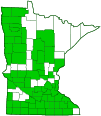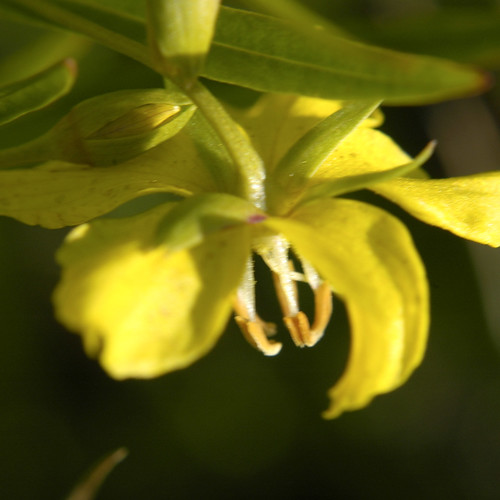four-flowered yellow loosestrife
(Lysimachia quadriflora)
Conservation • Wetland • Description • Habitat • Ecology • Use • Distribution • Taxonomy
Description |
||
Four-flowered yellow loosestrife is a 8″ to 27″ tall, erect, perennial forb that rises from a slender, horizontal, creeping, underground stem (rhizome). Rosettes of basal leaves can sometimes be found near the base of the plant rising from the parent rhizome. The stems are slender, erect or strongly ascending, and hairless. They may appear unbranched or have short branches above the middle. However, the lower nodes usually have very short branches appearing as a cluster of leaves in the leaf axils. Basal leaves are egg-shaped to elliptic, are shorter than stem leaves, and are on long leaf stalks. They are usually absent by flowering time. Stem leaves are opposite but sometimes appear whorled due to the leaves in the leaf axils. They are stalkless or nearly stalkless. The leaf blades are linear to very narrowly lance-shaped, 1¼″ to 3½″ long, and 1 ⁄16″ to ¼″ wide. They taper to a sharp point at the tip and are angled or tapered at the base. The upper surface is green to dark green, shiny, and hairless. The lower surface is pale green and hairless. The midvein is prominent and there are no evident secondary veins. The leaf surfaces are not dotted or pitted (punctate). The margins are untoothed, curled under, and may have a fringe of a few long hairs near the base. The inflorescence is a single flower or whorl of flowers rising from middle and upper leaf axils. Each flower nods at the end of a hairless, ⅝″ to 1⅜″ long stalk. The arrangement often appears as a whorl of four flowers, each one pointing in a different direction and nodding at the end of a slender stalk. Each flower is ½″ to 1″ in diameter. There are 5 sepals, 5 petals, 5 stamens and a single style. The sepals are united at the base into a very short tube (calyx) then separated at the tip into 5 widely spreading, narrowly lance-shaped, ⅛″ to ¼″ long lobes. They are yellow tinged with green and have 3 to 5 parallel, often reddish-brown veins. They are hairless, not gland-dotted, and not punctate. The petals are yellow, widely spreading, more or less round, and ¼″ to ⅜″ in diameter. They are reddish at the base. They taper abruptly to a point at the tip. The margins are mostly smooth but may be irregularly toothed, appearing gnawed (erose), near the tip. The stamens are free, not fused into a tube. They have yellow reddish and hairy, 1 ⁄16″ to ⅛″ long filaments. The style is ⅛″ to 3 ⁄16″ long. The fruit is a hairless, shiny, spherical to broadly egg-shaped, ⅛″ to 3 ⁄16″ in diameter capsule. The spreading lobes of the calyx persist when in fruit. The style also persists as a long sharp spine at the tip. The capsule contains up to 20 or more seeds and ripens in the fall. |
||
Height |
||
8″ to 27″ |
||
Flower Color |
||
Yellow |
||
Similar Species |
||
Fringed loosestrife (Lysimachia ciliata) is a larger, more robust plant. The leaves are broad, up to 2⅜″ wide, and have a fringe of hairs along the margins. Whorled loosestrife (Lysimachia quadrifolia) leaves appear in whorls of mostly 4. The leaf blades are broad, elliptic, up to 1⅜″ or more wide. |
||
Habitat |
||
Moist to wet. Prairies, meadows, edges of ponds and marshes, calcareous fens, bogs, swamps, roadside ditches. In lime-rich soil. |
||
Ecology |
||
Flowering |
||
July to August |
||
Pests and Diseases |
||
|
||
Use |
||
|
||
Distribution |
||||
|
Sources |
|||
| 9/17/2022 | ||||
Nativity |
||||
Native |
||||
Occurrence |
||||
Common |
||||
Taxonomy |
|||
| Kingdom | Plantae (Plants) | ||
| Division | Tracheophyta (Vascular Plants) | ||
| Subdivision | Spermatophytina (Seed Plants) | ||
| Class | Magnoliopsida (Dicots) | ||
Order |
Ericales (heathers, balsams, primroses, and allies) | ||
Family |
Primulaceae (primroses) | ||
| Subfamily | Myrsinoideae (cape myrtle) | ||
Genus |
Lysimachia (loosestrifes) | ||
Subordinate Taxa |
|||
Synonyms |
|||
Lysimachia longifolia Steironema quadriflorum |
|||
Common Names |
|||
four-flower yellow-loosestrife four-flowered yellow loosestrife fourflower yellow loosestrife linear-leaf loosestrife narrow-leaved loosestrife prairie loosestrife |
|||
Glossary
Axil
The upper angle where a branch, stem, leaf stalk, or vein diverges.
Calyx
The group of outer floral leaves (sepals) below the petals, occasionally forming a tube.
Erose
Irregularly toothed, appearing as if gnawed.
Linear
Long, straight, and narrow, with more or less parallel sides, like a blade of grass.
Node
The small swelling of the stem from which one or more leaves, branches, or buds originate.
Punctate
Dotted with pits, translucent sunken glands, or colored spots of pigment.
Rhizome
A horizontal, usually underground stem. It serves as a reproductive structure, producing roots below and shoots above at the nodes.
Sepal
An outer floral leaf, usually green but sometimes colored, at the base of a flower.
Visitor Photos |
|||||
Share your photo of this plant. |
|||||
| This button not working for you? Simply email us at info@MinnesotaSeasons.com. Attach one or more photos and, if you like, a caption. |
|||||
|
|||||
MinnesotaSeasons.com Photos |
|||||
Inflorescence |
|||||
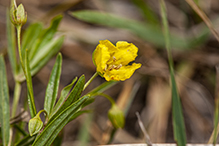 |
|||||
Flower |
|||||
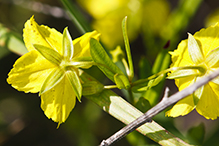 |
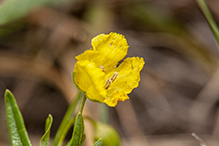 |
||||
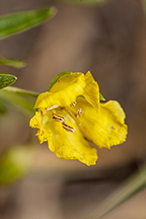 |
|||||
Leaves |
|||||
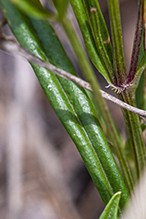 |
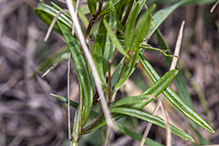 |
||||

Visitor Videos |
|||
Share your video of this plant. |
|||
| This button not working for you? Simply email us at info@MinnesotaSeasons.com. Attach a video, a YouTube link, or a cloud storage link. |
|||
Other Videos |
|||

Visitor Sightings |
|||||
Report a sighting of this plant. |
|||||
| This button not working for you? Simply email us at info@MinnesotaSeasons.com. Be sure to include a location. |
|||||
|
|||||
MinnesotaSeasons.com Sightings |
|||||

|
Created: Last Updated: © MinnesotaSeasons.com. All rights reserved. |
